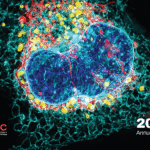Cracking a Cancer Code: How Simulations Are Guiding Smarter Drug Design
01 Mar, 2025
Recent News
- A Century Ago Quantum Mechanics Reshaped Physics. Today, it’s Revolutionising Medicine – One Diamond at a Time
- Crystals, Colour Centres, and the Brain: Quantum Sensing Using Lab-grown Diamonds
- Tiny Thermometers, Big Impact: Meet Farrel Separgo’s Vision for Future Diagnostics
Some of the most important breakthroughs in medicine happen at the tiniest scales, like inside our cells, where proteins quietly control life and disease. One such protein, NHE1, plays a key role in helping cancer cells survive in harsh environments.
In a study published in The Journal of Physical Chemistry B, Centre researchers from the University of Wollongong use powerful molecular simulations to reveal detailed insights into how this protein interacts with potential drug molecules. Their findings offer a detailed map of how to block NHE1’s activity, paving the way for more targeted and effective cancer treatments.
This work reflects QUBIC’s mission to understand life at the molecular level using advanced computational tools. While this study uses classical simulations, it lays the foundation for future quantum-enhanced approaches that could model even more complex biological systems with greater precision. By showing how drug molecules can latch onto NHE1 and shut it down, the research provides a critical piece of the puzzle in designing next-generation therapies, not just for cancer, but also for heart disease and other conditions where this protein plays a role.
By unlocking molecular-level insights through advanced simulation, this work lays the foundation for a new era of precision medicine.
Published paper: Ion Transport and Inhibitor Binding by Human NHE1: Insights from Molecular Dynamics Simulations and Free Energy Calculations (2024)
 This impact story is an extract from QUBIC’s 2024 Annual Report: read more.
This impact story is an extract from QUBIC’s 2024 Annual Report: read more.